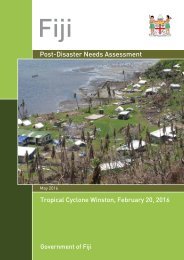Vanuatu_PDNA_Web
Vanuatu_PDNA_Web
Vanuatu_PDNA_Web
You also want an ePaper? Increase the reach of your titles
YUMPU automatically turns print PDFs into web optimized ePapers that Google loves.
16 Tropical Cyclone Pam, March 2015<br />
3.1 Productive Sectors<br />
3.1.1 Agriculture, Livestock, Forestry, and Fisheries<br />
Summary<br />
For the purpose of this <strong>PDNA</strong>, the agricultural sector is defined to include the crops, livestock,<br />
fishery, and forestry subsectors. The sector is dominated by crops, which represented 79% of<br />
the agriculture sector contribution to GDP in 2013, significantly higher than livestock (14%),<br />
forestry (5%), and fisheries (3%).<br />
Total agriculture<br />
sector damage<br />
and losses caused<br />
by Tropical<br />
Cyclone Pam are<br />
estimated to be<br />
slightly less than<br />
VT6.1 billion.<br />
Total agriculture sector damage and losses caused by Tropical Cyclone Pam are estimated to<br />
be slightly less than VT 6.1 billion. Consistent with its share in sector GDP, the crop subsector<br />
was the most affected (69%), followed by forestry (16%), livestock (9%), and fishery (6%) (see<br />
Figure 5). Permanent crops, such as kava, banana, coconut, cocoa, and coffee, were the most<br />
impacted by the cyclone, but seasonal crops (vegetables) and annual crops (cassava, taro) also<br />
suffered important losses. Livestock subsector damage and losses occurred mainly in Shefa and<br />
Tafea Provinces, mostly for commercial poultry farms and for pigs and apiculture activities. In<br />
the forestry subsector, damage to infrastructure and trees affected the timber industry in Tafea<br />
and Shefa. The fishery sector was also affected, with the heaviest impact on artisanal fisheries<br />
and commercial aquaculture.<br />
Agriculture, Livestock, Forestry, and Fisheries Sector Background<br />
The agriculture sector represented approximately 25% of the VT 75.8 billion GDP in 2013. Approximately<br />
80% of <strong>Vanuatu</strong>’s population relies on agriculture (mainly crops, livestock, and fisheries)<br />
for livelihood and food and nutrition security, and at least 71% of the rural population derives<br />
some income from agricultural activities (VNSO 2013). <strong>Vanuatu</strong>’s agriculture sector is dominated by<br />
semi-subsistence farmers using mostly household labor, who are located in tiny village communities<br />
spread throughout the archipelago. Food is the most important household expenditure item among<br />
rural households, representing 56% of total household expenditure, with the large share of the value<br />
of this expenditure being for home consumption among subsistence farmers. 7<br />
7<br />
Based on the <strong>Vanuatu</strong> 2010 Household Income and Expenditure Survey, <strong>Vanuatu</strong> National Statistic Office, Port<br />
Vila, <strong>Vanuatu</strong>.<br />
Figure 5. Agriculture<br />
Damage and Losses<br />
by Subsector and<br />
Affected Province<br />
(VT million)<br />
Livestock<br />
546 9%<br />
Forestry<br />
951 16%<br />
Malampa<br />
691 11%<br />
Shefa<br />
1,866 31%<br />
Crops<br />
4,175 69%<br />
Damage and losses by<br />
subsector<br />
Fisheries<br />
391 6%<br />
Penama<br />
2,023 33%<br />
Damage and losses by<br />
affected province<br />
Tafea<br />
1,483 24%



